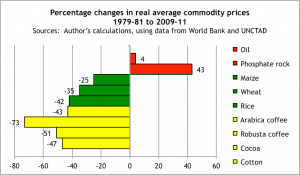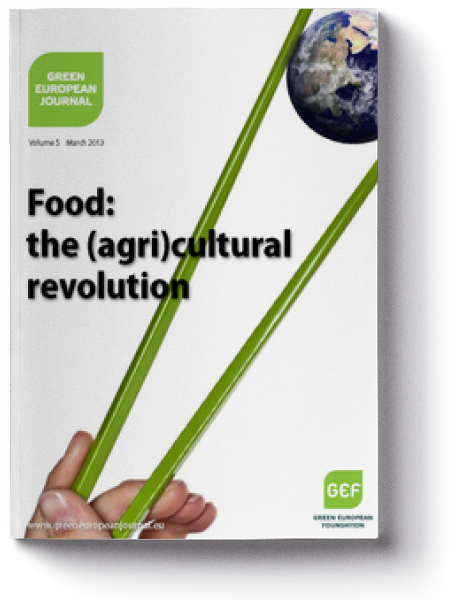The last six years have produced severe shocks to global food prices and supplies. This was felt especially hard by the poorest countries and the most vulnerable people.In the debate about those shocks, it is generally assumed that food prices have reached their highest ever levels and are unlikely to fall back far. However, that runs counter to the volatile history of the commodities trade, and of basic food prices in particular.
A closer look at food prices
Close examination of the recent price changes reveals a rather different story – but one that may be even more far-reaching. So what has happened to the prices of the world’s food and agricultural products? And what do those changes imply?
These questions are examined in a paper from the British think-tank Green House, called ‘Primary Commodity Prices and Global Food Security: Why farmers still struggle when food prices rise’.
It investigates the movements of 24 global commodity prices since the last time there was a big commodity price boom, in the late 1970s, to see what can be learnt about the economy of food and agriculture. To take increases in other prices into account, the price changes were set against the average prices of manufactured goods, using the World Bank’s Index of the Unit Value of Manufactured Goods.

Fig. 1 shows the results of this study for nine important agriculture-related commodities. They include two minerals (oil and phosphates), the world’s three most important cereal crops (rice, maize and wheat) and four tropical export crops, which are vital to the foreign trade of many poor countries.
An uneven change
It turns out that over this period, the real prices of the three cereals did not rise sharply but moved roughly in line with manufactures. The price of rice – the world’s most important foodstuff – actually fell significantly in relation to manufactured goods. There are hardly any signs here of a ‘Peak Food’ phenomenon, equivalent to Peak Oil: these market prices do not provide evidence of any substantial long-term shortage of basic foods.
With the sudden increase in cereal prices in 2007-08, the aid agencies’ advice to rely on world markets for food security, while earning revenue from commodity exports, equally suddenly failed.
On the other hand, the prices of oil and phosphates (as well as other fertilisers) did rise much more than the cereal prices. And these are the leading inputs in modern agriculture. The changes seen in their prices lend clear support to the Peak Oil theory – and also what might be called ‘peak’ fertilisers and other minerals.
A background factor, which is not often mentioned, is the depressing effect on world grain prices caused during the 1980s and 1990s by the gradual reduction of U.S. and European Union cereal stocks. This was due to changes in agricultural policy. The long process of sales ended shortly before the price spike of 2007-08. The corresponding pressure on developing countries to liberalise their agricultural policies and open their markets to imports was associated with the offloading of these stocks.
A steady post-war decline
In developing countries the recent food and commodity price shocks were transmitted from the world economy.
The poorest and least developed countries depend on commodity markets almost by definition, because they produce few other goods that they can export. Many of their exports are of agricultural products such as cotton and coffee. And many of these crops, such as coffee, cocoa and cotton, fell in price when compared to manufactured goods – and most of all the robusta variety of coffee, which is produced in many small, poor African countries.
The impact on developing countries
These developments are especially dispiriting for the numerous countries where food imports grew, under pressure from the cheap U.S. and European cereal exports. With the sudden increase in cereal prices in 2007-08, the aid agencies’ advice to rely on world markets for food security, while earning revenue from commodity exports, equally suddenly failed.
That greatly increased those countries’ commercial vulnerability. Their balances of payments would have been in better shape if they had grown enough cereals instead of importing them, and produced and exported less cocoa, sugar, coffee and similar crops.
Taken together, this evidence has serious implications for the future of agriculture. It suggests not so much a crisis of agriculture or food supplies in general as one of intensive, mineral- and chemical-dependent agriculture in particular. Farmers and farm workers are unable to profit from higher crop prices because of the faster-growing costs of inputs, which can also be a big drain on a country’s balance of payments.
The generational consequences of this crisis
This has created a crisis of agricultural incomes, and consequently an ageing farming population and a worldwide problem of finding a new generation of farmers. Agriculture has become so poorly paid that young people in countries at all levels of development are going into other lines of work rather than following their parents on to family farms. Farming populations are growing older and there is a danger that, eventually, not enough food will be grown because there are not enough farming people left to grow it.
I know of no systematic research on this, but the anecdotal evidence is overwhelming: in country after country – Kenya, Nigeria, China, France, the U.K., to name but a few – one hears of an ageing agricultural population and the refusal of young people to stay on farms. I have even heard of it in relation to South Korea, where agricultural subsidies are some of the highest in the world.
The food price shocks, and the failure of farmers and rural workers to benefit much from higher prices, are elements of a wider agricultural crisis.
The need for a new approach
This surely demonstrates that it is time for a completely new approach to agriculture and food security. The food price shocks, and the failure of farmers and rural workers to benefit much from higher prices, are elements of a wider agricultural crisis. Dependence on unstable global markets, the growing uniformity of the world’s main foods, and vulnerability to shocks appearing from those markets, are all features of this problem.
If we continue further down this path, we only risk a further increase in the external vulnerability of many countries. They need to be protected from world price shocks in order to reduce the risk of these events recurring, and to decrease their severity if and when they do occur.
In this light, the Green House paper offers this general guidance on future priorities:
- Reduce the reliance of agriculture on oil, agro-chemicals and mineral fertilisers;
- Review the balance between domestic food production and crops for export;
- Reduce the reliance for food supplies on rice, maize and wheat – the major globally traded cereals.
It suggests the following series of policies in support of these goals:
- In food and agriculture, give precedence to trade with neighbouring countries and to domestic trade;
- Permit greater use of tariffs and other border controls in agricultural trade;
- Provide incentives to encourage the production and consumption of traditional crops and especially those which are little traded internationally – of which, in most countries, there are very many;
- Reduce reliance on mineral and chemical fertilisers and crop-protection agents, by promoting green manures, agro-forestry and other ecologically sustainable techniques;
- Use both modern and traditional methods of these sorts to build up natural resilience and sustainability.
A shock-proof system
A concerted attempt to encourage farmers to build on their own knowledge, and to promote traditional foodstuffs and ecological ways of farming, would help to overcome these problems. It would reduce vulnerability to imported market shocks, while the foreign exchange costs of agriculture would be reduced through the lesser use of imported inputs.
Farmers and agricultural workers would benefit more fully from higher crop prices because fewer inputs would have to be bought. Their production costs would be lower, and they would have more money to spend and could invest more.
Until recently, all these questions were overlooked by most agricultural research. They are still ignored in the mainstream debate on agriculture and food security.
But the inadequacies of the world’s dominant farming system have been laid bare since the 2008 crisis. We need to find ways to insulate vulnerable countries from world market shocks and build on already known methods – a greater variety of staple crops, traditional farming techniques, agro-ecology – to create a food system which is economically, as well as ecologically, more resilient and sustainable.

